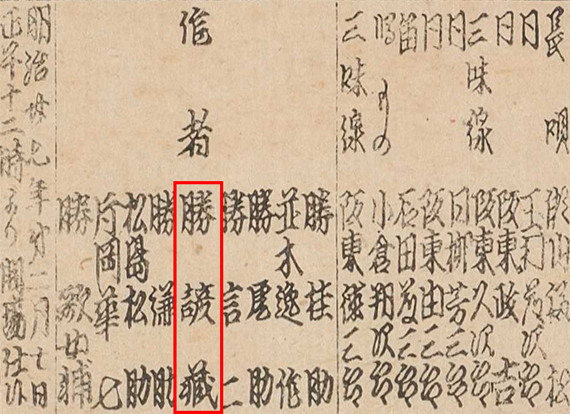| KATSU GENZď III |
|
Pen names:
Other name:
Line number: SANDAIME (III) Existence: 1844 ~ 27 October 1902 Connection: Father: Kawatake N˘shin II (Katsu Genz˘ II) Master: Segawa Jok˘ III Disciples [1]: Katsu Hikoji, Katsu Keisuke, Katsu Keiji Career: 5th lunar month of 1844: born in Edo in Asakusa, in either Saruwaka-ch˘ or Suwa-ch˘. 1862: he started his career as a disciple of Segawa Jok˘ III. His first pen name was Hama Hikosuke. 1870: Hikosuke and his father Katsu Genz˘ II settled in ďsaka. 1872: Hikosuke became tatesakusha. 3rd lunar month of 1872: the drama "Z˘ho Chűshingura" [2] was staged for the first time in ďsaka in kodomo shibai at the Inari Shibai. 1874: he took the name of Katsu Hikosuke and went on tour in Matsusaka with a troupe led by Nakamura S˘jűr˘. 1875: he stopped working as a sakusha for one year. With his first wife Osen, he rented a room in a chaya named Otafukuya in the district of Nanba and they used it as a kamiyui shop. September 1876: Hikosuke was back in the Kabuki world; he worked with his father Katsu Genz˘ II at the Ebisuza on the drama "Gokoku Onna Taiheiki", which starred Jitsukawa Enjaku I, Nakamura Jakuemon II, Nakamura Fukusuke III, Nakamura Kashichi IV, Jitsukawa Enzabur˘ III, Jitsukawa Sh˘ch˘, Nakamura Hikaku and Asao Yoroku III. April 1878: Katsu Genz˘ II and his son Katsu Hikosuke respectiveley took the names of Katsu N˘shin and Katsu Genz˘ III. They worked together at the Naka no Shibai on the dramas "Kinsei Sakurada Yuki no Kikigaki", "Miyakodori Nagare no Shiranami" and "Santo Meisho Utsusu Irodori". 28 June 1881: his master Segawa Jok˘ III died. March 1882: premiere at the Kado no Shibai of Genz˘'s drama "Seichű Gishi Genroku Kabuki", a revised and reworked version of three acts which were added by Segawa Jok˘ III to the classic "Kanadehon Chűshingura" in the in the 5th lunar month of 1856 at the Moritaza. Genz˘ made it as an independent play. As he was no more subjected to censorship, Genz˘ was able to use the real names of the protagonists and, in this new version, Lord Matsukura became Lord Matsuura. This role was played by Nakamura Tokiz˘ I. 1884: Katsu N˘shin and his son Katsu Genz˘ III respectiveley took the names of Kawatake N˘shin II and Takeshiba Genz˘ II. May 1885: Genz˘, along with his father Kawatake N˘shin II and the sakusha Namiki Sh˘z˘ III, worked at the Ebisuza on the first Kabuki adaptation of a William Shakespeare's drama; "The Merchant of Venice" was adapted under the title of "Sakuradoki Zeni no Yo no Naka". It has been said that this adaptation is based on Charles and Mary Lamb's "Tales from Shakespeare". This original drama starred Nakamura S˘jűr˘, Nakamura Tsurusuke V, Band˘ Jusabur˘ II, Arashi Kitsusabur˘ IV, Jitsukawa Enzabur˘ III, Arashi Rish˘ II, Arashi Minshi V, Jitsukawa Wakamatsu, ďtani Tomoji, Nakamura Kohakur˘, Nakamura Shikin, Ichikawa Ichiroku and Band˘ Azuma. 26 October 1886: his father Kawatake N˘shin II died [3]. April 1887: premiere at the Nakaza of Genz˘'s drama "Nikaigasa Yagyű Jikki" [casting]. Spring 1893: he settled in T˘ky˘, took back the name of Katsu Genz˘ III and became tatesakusha at the Harukiza. During his stay in T˘ky˘, he did some lobbying to take the name of Tsuruya Nanboku VI but he failed. He also divorced his second wife Osei [4]. February 1894: Genz˘ worked at the Kadoza on the dramas "Wake no Kiyomaro", "Go Taiheiki Shiraishi Banashi" and "Yamatogana Ariwara Keizu". 27 October 1902: Genz˘ died in ďsaka. Comments: Katsu Genz˘ III was born and trained in Edo but, following his father, he became a leading Meiji sakusha in ďsaka. He worked along with his father on 300 original Kabuki or Shinpa dramas but only "Nikaigasa Yagyű Jikki" is still in the Kabuki repertoire. At the end of his career, he considered himself as not being a member of the Kawatake clan and severed his relationship with this important family of sakusha. [1] In Nojima Jusabur˘'s book "Kabuki Jinmei Jiten", it was reported that he had around 40 disciples all over his career. [2] According to Nojima Jusabur˘'s "Kabuki J˘ruri Gedai Yomikata Jiten", the author was Hama Hikosuke. [3] His first wife Osen fell ill and died the same year. [4] She was the younger sister of the wife of the rakugo storyteller Ryűtei Enshi I.
The name of Katsu Genz˘ III in a 1894 ďsaka ezukushi banzuke (the zone within the red shape on the left side of the picture) The Takeshiba Genz˘ line of playwrights The Katsu Genz˘ line of playwrights |
|
|
| Contact | Main | Top | Updates | Actors | Plays | Playwrights | Programs | Links | FAQ | Glossary | Chronology | Illustrations | Prints | Characters | Derivatives | Theaters | Coming soon | News |
